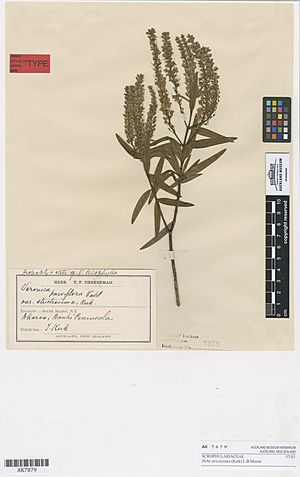Banks Peninsula hebe facts for kids
Quick facts for kids Banks Peninsula hebe |
|
|---|---|
 |
|
| A preserved sample of the Banks Peninsula hebe | |
| Scientific classification | |
| Genus: |
Veronica
|
| Species: |
strictissima
|
Veronica strictissima, also known as the Banks Peninsula hebe, is a special kind of flowering plant. It belongs to the Plantaginaceae family. You can only find this plant growing naturally on the Banks Peninsula in New Zealand.
Contents
About the Banks Peninsula Hebe
The Banks Peninsula hebe is a bushy plant that can grow up to 2 metres tall. Its Latin name, strictus, means "erect." This describes its upright branches. These branches are often smooth, without hairs, or have tiny hairs arranged in pairs. Sometimes, the branches can look a bit red.
Leaves and Flowers
The leaves of this hebe are long and narrow, about 2 to 4.5 centimetres long and 6 to 8 millimetres wide. They are light green and smooth. The edges of the leaves are usually plain, but sometimes they have tiny hairs. The leaves grow in pairs directly opposite each other on the stem. Each new pair turns 90 degrees from the pair below it.
The flowers are white and grow in a long cluster called a raceme, which can be up to 11 centimetres long. Some flowers have both male and female parts (these are called hermaphrodite flowers). Other flowers are only female. This means some plants have both types of flowers, and some plants only have female flowers. This is called being gynodioecious.
Tiny stalks, called pedicels, hold the flowers. These stalks are covered in small hairs. The green outer leaves of the flower, called the calyx, are oval-shaped. Inside the flower, the tube-shaped part of the petals, called the corolla tube, is hairy.
Reproduction
The male parts of the flower are called stamens, and they are 3 to 5 millimetres long. The tips of the stamens, called anthers, are purple. The female part, called the style, is 2.3 to 6 millimetres long.
After the flowers are pollinated, small cases called capsules form. These capsules contain many tiny, flat, brown seeds. The seeds are about 1 to 1.6 millimetres long. When the capsules open in autumn, the seeds are released. The wind helps spread these seeds. Birds and lizards can also help move the seeds around.
Where It Lives
New Zealand Home
The Banks Peninsula hebe is native to New Zealand. This means it naturally grows there and nowhere else in the world. Specifically, it is found only on the Banks Peninsula in the Canterbury Region. All natural discoveries of this plant have been in the Port Hills and Akaroa areas of the Banks Peninsula.
Preferred Places to Grow
Veronica plants, including the Banks Peninsula hebe, grow quickly. They like sunny, open areas. You can find them in places like scrubland, on steep hillsides, and on cliffs. The Banks Peninsula has different weather conditions than the rest of Canterbury.
This hebe grows at different heights, from near the coast up to at least 800 metres above sea level. It does not like too much shade. It is also a ruderal species, which means it grows well in places that have been disturbed, like after a landslide or fire.
Life Cycle
The Banks Peninsula hebe starts to grow new flowers after a period of spring growth. It usually flowers during the summer months, from December to March. Some plants might even flower until June. Each individual plant will flower for about 2 to 5 weeks. All the flowers on one plant's stalk usually bloom at the same time.
The seed capsules form from March to April. The seeds are released in autumn. The wind helps spread these seeds. Birds and lizards also help by eating the fruit and spreading the seeds. A special native bee, called Lasioglossum sordidum, is the main pollinator for these flowers. This bee feeds on the nectar and carries pollen from flower to flower.
What It Needs to Grow
The soil on the Banks Peninsula is different from other parts of Canterbury. It is made of a type of soil called loess and basalt rock. The Banks Peninsula hebe prefers soil that has a moderate amount of moisture. It also likes soil that is not too salty and drains water well.
Who Eats It or Lives On It
Grazing animals like sheep, goats, and cows sometimes eat the Banks Peninsula hebe. Lizards and birds also eat the fruit and drink the nectar from the flowers.
Besides the native bee that pollinates it, other insects also live on this plant. These include the hebe plume moth (Platyptilia) and large hebe loopers (Xyridacma veronicae). Tiny insects like hebe gall midges, hebe leaf miner flies, and hebe gall mites also feed on the Banks Peninsula hebe.
Traditional Uses
Historically, the Banks Peninsula hebe was used for medicine. It was used as a cure for dysentery, a type of stomach illness. It was even used effectively during the Second World War.
The Māori people traditionally used this plant for various purposes. They made a special liquid, called a decoction, from it to treat ulcers, headaches, and problems with kidneys and the bladder.
Other Interesting Facts
The Banks Peninsula hebe can sometimes be mistaken for other hebe species. In the past, it was thought to be the same as Hebe leiophylla or Veronica parviflora. It looks very similar to Hebe traversii, which grows in many more places like Canterbury, Marlborough, and Nelson.
Scientists think that the Banks Peninsula hebe might be able to mix with Hebe salicifolia to create new types of plants. A possible example of this mix has been found in a plant collection in Wellington.
This plant also helps the environment by preventing soil from washing away, which is called controlling erosion.

